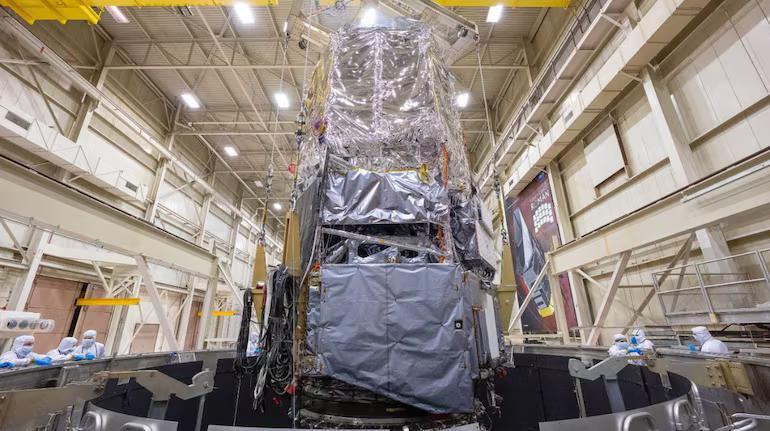
NASA’s Roman telescope passes critical tests ahead of 2027 launch
The Nancy Grace Roman Space Telescope, a cutting-edge astronomical observatory developed by NASA, has successfully cleared a crucial round of trials ahead of its scheduled launch in 2027. The telescope’s outer structure was subjected to a series of intense vibration and acoustic tests, designed to simulate the shaking and sound blasts it will experience during lift-off. Additionally, the inner portion of the telescope underwent a rigorous 65-day thermal vacuum test, pushing its components to their limits.
These comprehensive tests are a critical milestone in the development of the Roman Space Telescope, which is designed to conduct a wide range of astronomical observations, from studying the formation of galaxies and stars to investigating the properties of dark energy. The telescope’s solid performance in these conditions confirms that it is fit for launch and ready to begin its mission to explore the cosmos.
The vibration tests, which were conducted at NASA’s Goddard Space Flight Center in Maryland, were designed to simulate the intense shaking that the telescope will experience during launch. The tests involved attaching the telescope to a large vibration table, which was then used to subject the instrument to a range of frequencies and amplitudes, mimicking the conditions it will face during lift-off. The results of these tests showed that the telescope’s structure is robust and can withstand the stresses of launch, giving NASA engineers confidence that it will be able to survive the intense forces it will encounter during its journey into space.
In addition to the vibration tests, the telescope’s outer structure was also subjected to a series of acoustic tests, which were designed to simulate the sound blasts it will experience during launch. These tests involved exposing the telescope to a range of sound frequencies and intensities, from the low rumbles of the rocket’s engines to the high-pitched whine of the spacecraft’s systems. The results of these tests showed that the telescope’s structure is able to withstand the intense sound pressures it will encounter during launch, without suffering any damage or degradation.
The inner portion of the telescope, which includes its sensitive optical and electronic components, was also put through a rigorous series of tests, including a 65-day thermal vacuum test. This test involved placing the telescope’s inner components in a large vacuum chamber, where they were subjected to a range of temperatures, from the freezing cold of space to the scorching heat of the Sun. The test was designed to simulate the extreme temperature fluctuations that the telescope will experience during its mission, and to ensure that its components can operate reliably and efficiently in these conditions.
The results of these tests were extremely positive, with the telescope’s components performing flawlessly throughout the test period. The test showed that the telescope’s optical and electronic systems are able to operate reliably and efficiently, even in the extreme temperatures of space, and that they are able to withstand the stresses of launch and the harsh conditions of the space environment.
The successful completion of these tests is a major milestone in the development of the Roman Space Telescope, and marks an important step towards its scheduled launch in 2027. The telescope is expected to play a major role in advancing our understanding of the universe, and will conduct a wide range of astronomical observations, from studying the formation of galaxies and stars to investigating the properties of dark energy.
The Roman Space Telescope is a next-generation astronomical observatory, designed to conduct a wide range of scientific investigations, from the formation of galaxies and stars to the properties of dark energy. The telescope will be equipped with a range of advanced instruments, including a high-resolution camera and a spectrograph, which will allow it to study the universe in unprecedented detail.
The telescope’s camera, which is known as the Wide Field Instrument, will be capable of capturing high-resolution images of the universe, with a field of view that is 100 times larger than the Hubble Space Telescope. The camera will be equipped with a range of filters, which will allow it to study the universe in different wavelengths of light, from the ultraviolet to the infrared.
The telescope’s spectrograph, which is known as the Coronagraphic Instrument, will be capable of studying the properties of distant stars and galaxies, by analyzing the light they emit. The spectrograph will be equipped with a range of advanced technologies, including a coronagraph, which will allow it to block out the light from nearby stars, and study the faint light from distant galaxies.
The Roman Space Telescope is an important part of NASA’s ongoing efforts to explore the universe and to advance our understanding of the cosmos. The telescope will conduct a wide range of scientific investigations, from the formation of galaxies and stars to the properties of dark energy, and will provide scientists with a wealth of new data and insights into the workings of the universe.
In conclusion, the successful completion of the Roman Space Telescope’s critical tests is a major milestone in the development of this next-generation astronomical observatory. The telescope’s solid performance in these tests confirms that it is fit for launch and ready to begin its mission to explore the cosmos. With its advanced instruments and cutting-edge technologies, the Roman Space Telescope is poised to make major contributions to our understanding of the universe, and to advance the field of astronomy in the years to come.





